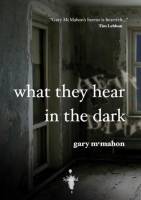‘What Happens When You Wake Up in the Night’ (2009) by Michael Marshall Smith
‘The Safe Children’ (2009) by Tom Fletcher
Nightjar Press is a new venture by the writer Nicholas Royle, specialising in individually-bound short stories. They’ve launched with two titles, one by a well-known writer, the other by a newcomer. Very handsome volumes they are — and, more importantly, the stories are also very good.
 The well-known writer is Michael Marshall Smith, whose name is pretty much a guarantee of a good read, and ‘What Happens When You Wake Up in the Night’ is no exception. It’s narrated by a little girl named Maddy who hates the dark, so (she tells us) made a deal with her mummy that she could keep the light on all night, as long as she didn’t disturb her parents. But tonight, Maddy has woken up in darkness; what’s happened to her light?
The well-known writer is Michael Marshall Smith, whose name is pretty much a guarantee of a good read, and ‘What Happens When You Wake Up in the Night’ is no exception. It’s narrated by a little girl named Maddy who hates the dark, so (she tells us) made a deal with her mummy that she could keep the light on all night, as long as she didn’t disturb her parents. But tonight, Maddy has woken up in darkness; what’s happened to her light?
The first thing to say about this story is that Smith gets Maddy’s voice pitch-perfect: with all the breathless sentences and repetitive structures, it feels as though this is a small child addressing us. And it’s the naiveté of Maddy’s viewpoint which is key to the success of the story. It becomes clear as the tale progresses that something strange is happening — and, all credit to Smith, it was something I didn’t see coming. But we get some idea of what’s going on, even though Maddy doesn’t; the gap between her knowledge and ours generates great poignancy. It was with something of a wry smile that I closed the book, having read Maddy’s final words: ‘Mummy and Daddy do not talk much any more, and this is why, if you wake up in the night, you should never ever get up out of bed.’ There’s a lot going on behind that sentence which I can’t reveal without spoiling the story — and I’d hate to deprive anyone of the superb reading experience I had with Smith’s tale.
 Nightjar’s second launch title is the beautifully harsh ‘The Safe Children’ by a young new writer named Tom Fletcher. Set in western Cumbria, it follows James Thwaite as he travels to his new job as overnight security guard at a factory which makes… well, that’s a secret. The plot leads towards the revelation of the factory’s purposde, which is appropriately nasty — but that revelation isn’t enough, by itself, to make the story stand out.
Nightjar’s second launch title is the beautifully harsh ‘The Safe Children’ by a young new writer named Tom Fletcher. Set in western Cumbria, it follows James Thwaite as he travels to his new job as overnight security guard at a factory which makes… well, that’s a secret. The plot leads towards the revelation of the factory’s purposde, which is appropriately nasty — but that revelation isn’t enough, by itself, to make the story stand out.
What does make this tale stand out for me is Fletcher’s prose, the way he captures the fundamental bleakness of his setting. The story is set in the near future, and perhaps its main theme is that of the promise of a shiny new tomorrow versus the failure of reality to deliver. Here, for example, is how James describes his train to work:
All of the seats are ripped; all of the tables are black with cigarette burns. Somebody is playing music on some portable device and it sounds like an insect trapped behind glass. The train moves slowly. I just stare out at the sea. Some things haven’t changed at all.
There are flashy, hi-tech trains and suchlike in this future world, but only in rich areas; where James lives, a couple are lucky if they can afford for both to eat at the same time — and the only hint of that shiny tomorrow is the shimmer of wet sand on the beach. The real horror of ‘The Safe Children’ is not the factory itself, but the socio-economic conditions that allowed it to come into being, and made people desperate enough to take jobs there.
Fletcher’s story is not without its flaws: the background details aren’t always integrated as naturally as perhaps they ought to be; they end up feeling ‘crammed in’, as though the story doesn’t give them enough space. Overall, however, ‘The Safe Children’ is an effective piece that marks Fletcher out as a writer for whom it’s worth keeping an eye out; he has a novel due to be published next year, which is now on my to-read list.
Also on my to-read list is anything that comes from Nightjar Press; if all its publications are going to be as good as these, they’ll need reading.
Like this:
Like Loading...
 The first of our new
The first of our new  Birds appear again, though in a rather different context, in Nightjar’s other new chapbook.
Birds appear again, though in a rather different context, in Nightjar’s other new chapbook. 
 The well-known writer is
The well-known writer is  Nightjar’s second launch title is the beautifully harsh ‘The Safe Children’ by a young new writer named
Nightjar’s second launch title is the beautifully harsh ‘The Safe Children’ by a young new writer named
Recent Comments